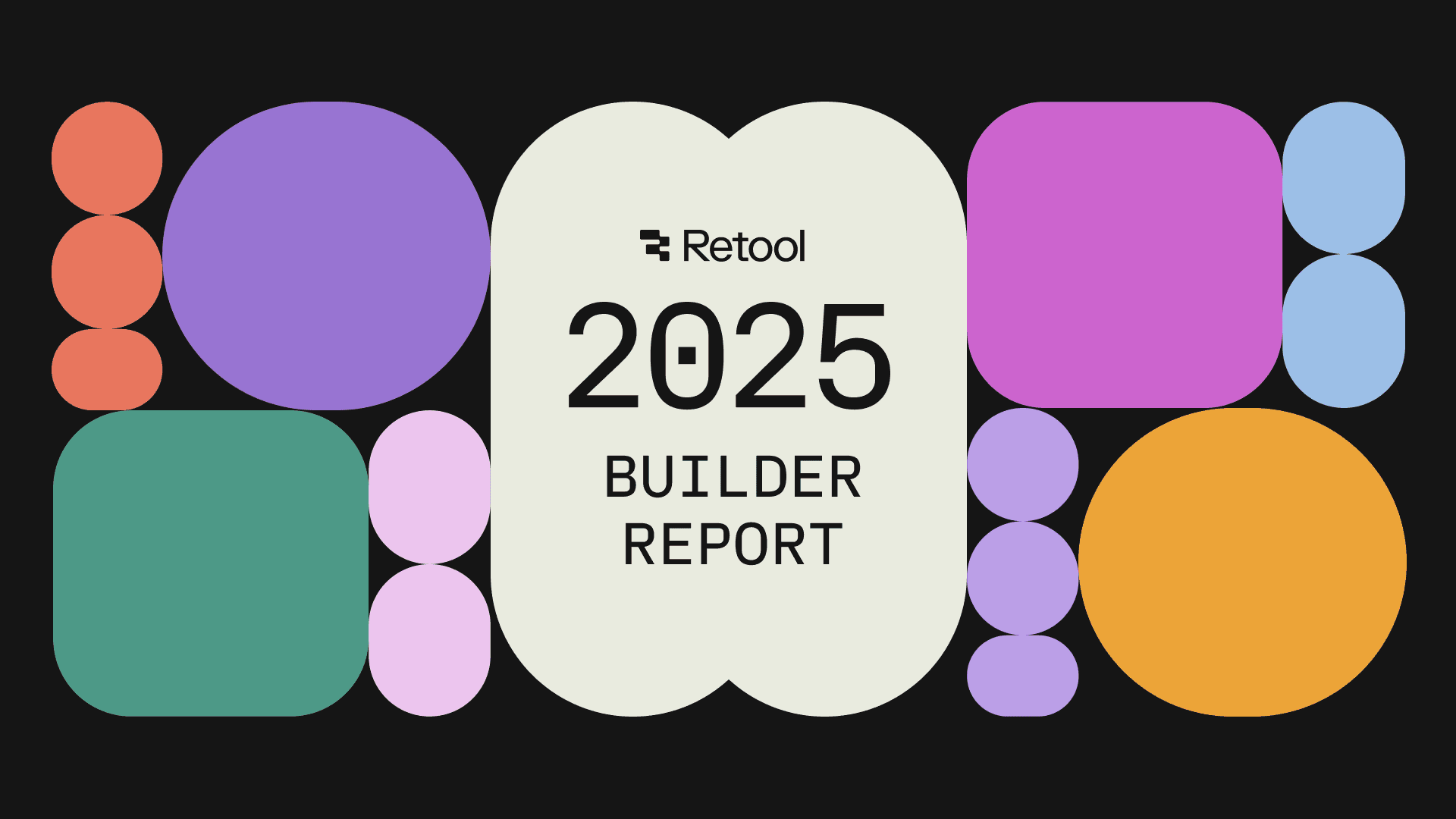Something fundamental is changing about who builds software. Operations managers are shipping dashboards. Product leaders are creating tools. Finance analysts are deploying apps their teams actually use. It’s a moment that feels like the confluence of low-code’s promise and AI’s potential—anyone in the business can solve any problem in an afternoon, saving everyone time in the process. But without structure, this vision becomes chaotic instead of complete.
Our survey of 1,128 Retool builders reveals that democratization in the right environment leads to company-wide gains: almost half of non-engineers can now build solutions themselves when they’re working within platforms that connect to live enterprise data and inherit organizational guardrails by default.
This is the promise of enterprise AppGen—production-ready apps built by business experts with guardrails in place from day one. We’re seeing this play out in real time: builders with the right knowledge solving their own problems.
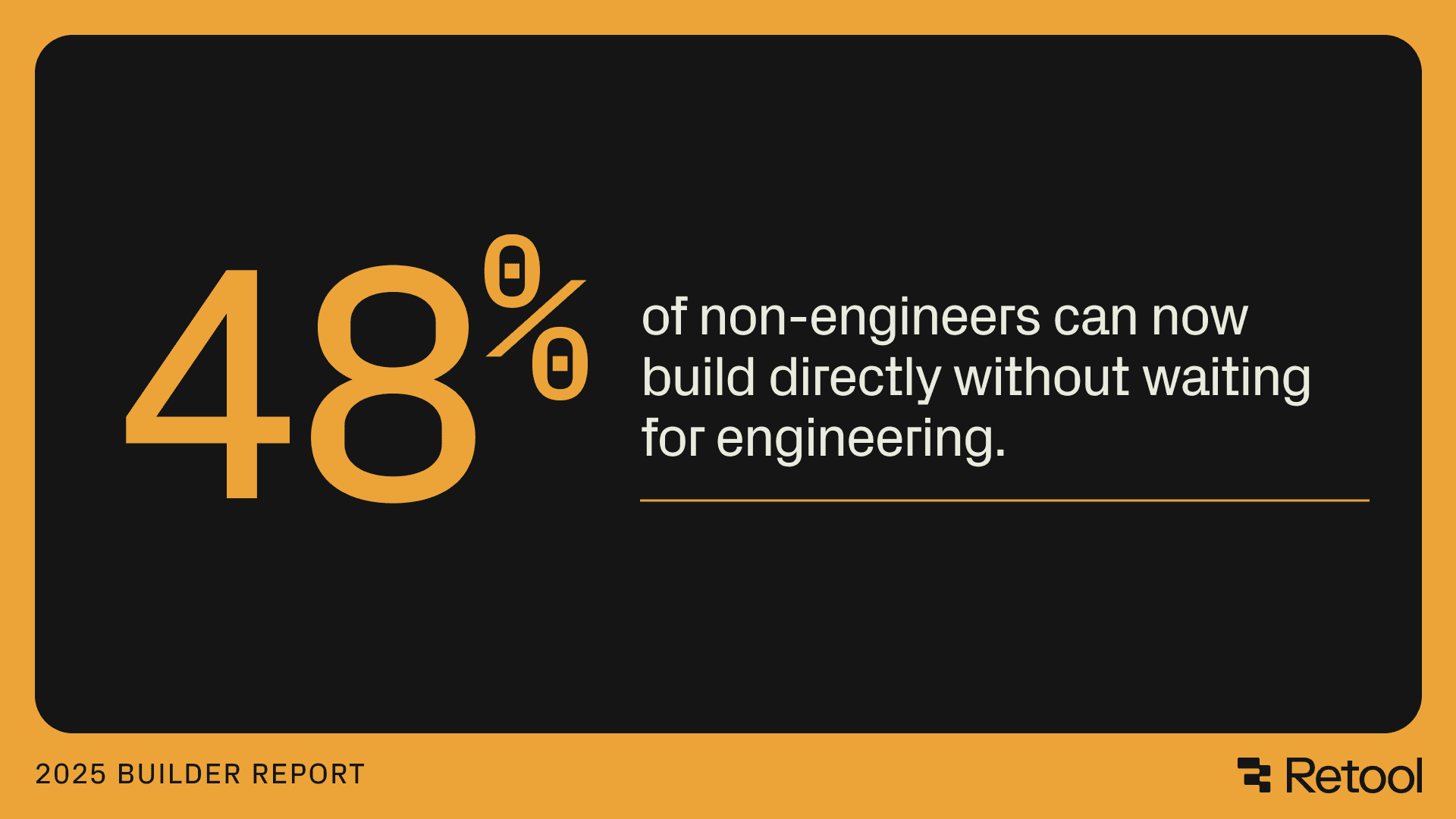
In this report, we uncover how AI productivity mandates are accelerating this transformation, how these new builders work, and what it all means for the economics of custom software. Here’s what we found:
AppGen is unlocking more builders across organizations. Only 35% of builders surveyed identified themselves as engineers or developers.
For company leaders:
- AI productivity mandates are becoming table stakes, with 66% of builders working under AI directives or encouragement.
- Business user builders deliver measurable results when productivity expectations are highest: 74% of builders are exceeding leadership’s expectations under AI mandates.
- The build-vs-buy decision now includes a third option: build with business users. 51% of builders now solve problems in days or weeks instead of months or quarters.
For business users:
- Building capabilities are becoming career differentiators, with leadership recognizing builders as strategic assets. 46% are recognized by leadership as someone who can “make things happen.”
- The ability to go from problem identification to solution implementation independently is increasingly valuable. 91% of builders report significant changes to how they work.
- Company leaders notice when builders get more done. 65% of builders say they meet or exceed leadership’s productivity expectations, regardless of AI mandates.
That backlash wasn’t enough to stop other companies from following suit (albeit quietly). Our study found two-thirds (66%) of builders are now working under explicit AI directives—from general encouragement to explore AI tools (40%) to specific productivity targets (26%).
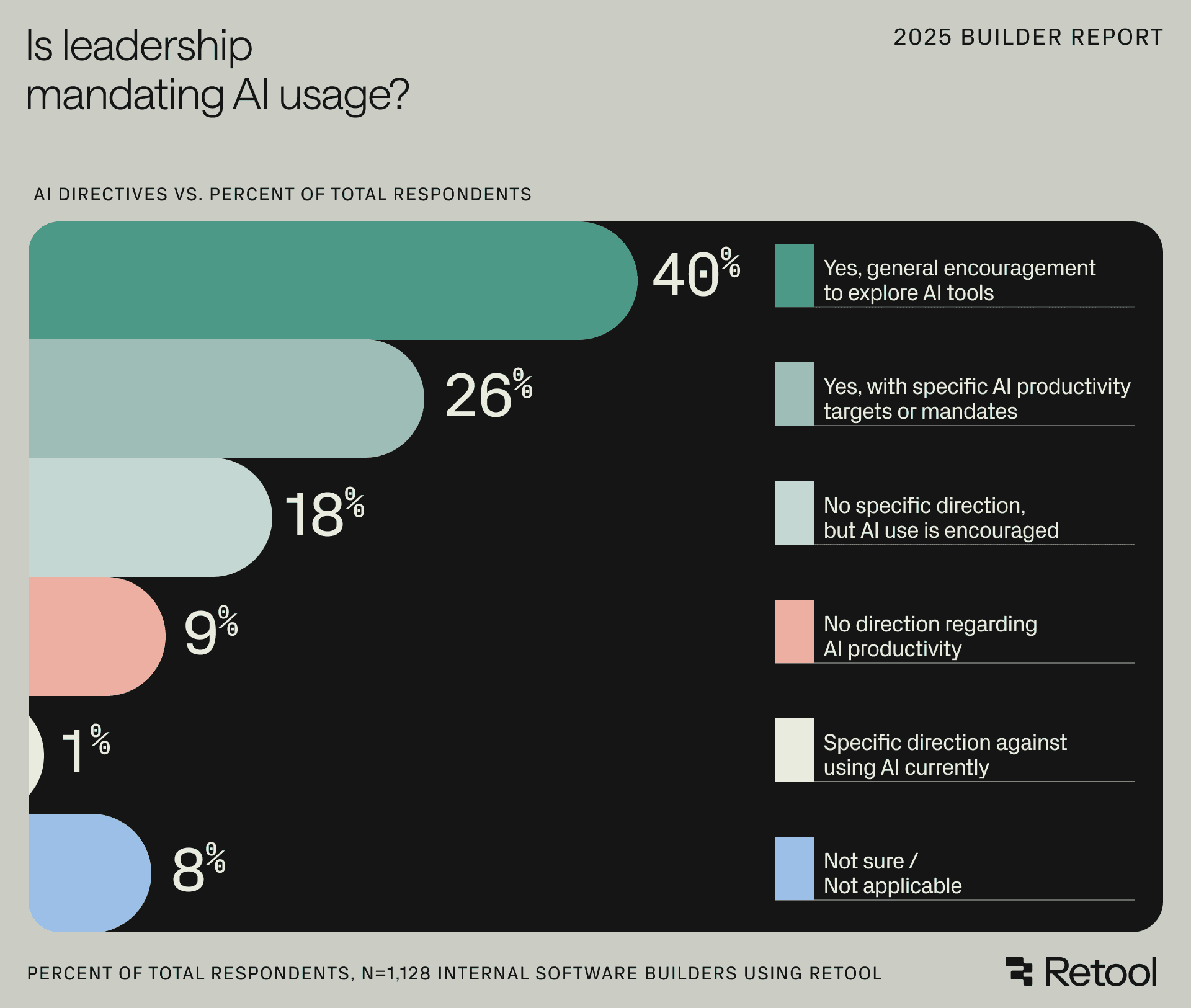
Only 9% of respondents say their organizations provide no AI direction whatsoever, while a mere 1% report explicit direction against AI use.
The companies didn’t feel the backlash hit their bottom line, either. In August, Duolingo announced that it beat its quarterly revenue estimates. The promise of AI’s ability to scale human work is winning out, and business leaders are noticing. But how will those policies turn into long-term returns?
Individual productivity gains from AI mandates are proving harder to scale into sustainable organizational productivity gains. A 2025 report from MIT found 95% of businesses aren’t seeing significant value from AI, and just 5% of custom enterprise AI tools reach production.
To overcome this AI productivity paradox, builders will need the right solutions, skills, and internal support.
The traditional lines between “technical” and “business” roles are getting blurry. Building effective production software used to be limited to who in the business could code: mostly engineers and developers, plus some domain experts who taught themselves coding basics.
Now, AI has given anyone the ability to write code, and AppGen has given them the ability to use that code to deploy apps safely.
Our survey of Retool builders found most aren’t software engineers. They’re operations managers, data experts, and other domain experts who are able to ship production software independently:
- 35% are software engineers or developers
- 13% are operations leaders
- 11% are product managers
- 8% are data analysts/scientists
- 5% are IT or systems administrators
- 5% are marketing/sales operations
- 6% are business analysts or in finance/accounting
An additional 18% responded “other,” bringing the total of non-engineers to 65%.
The data also shows high-impact building is not limited to the senior team: 15% of respondents are entry-level, 28% are mid-level, 27% are senior level and 31% are leadership or management-level.
Organizations are discovering that their most valuable employees may not be the most senior or the ones with the deepest technical knowledge. About two-thirds of these builders report they’re now better able to meet or exceed leadership expectations.
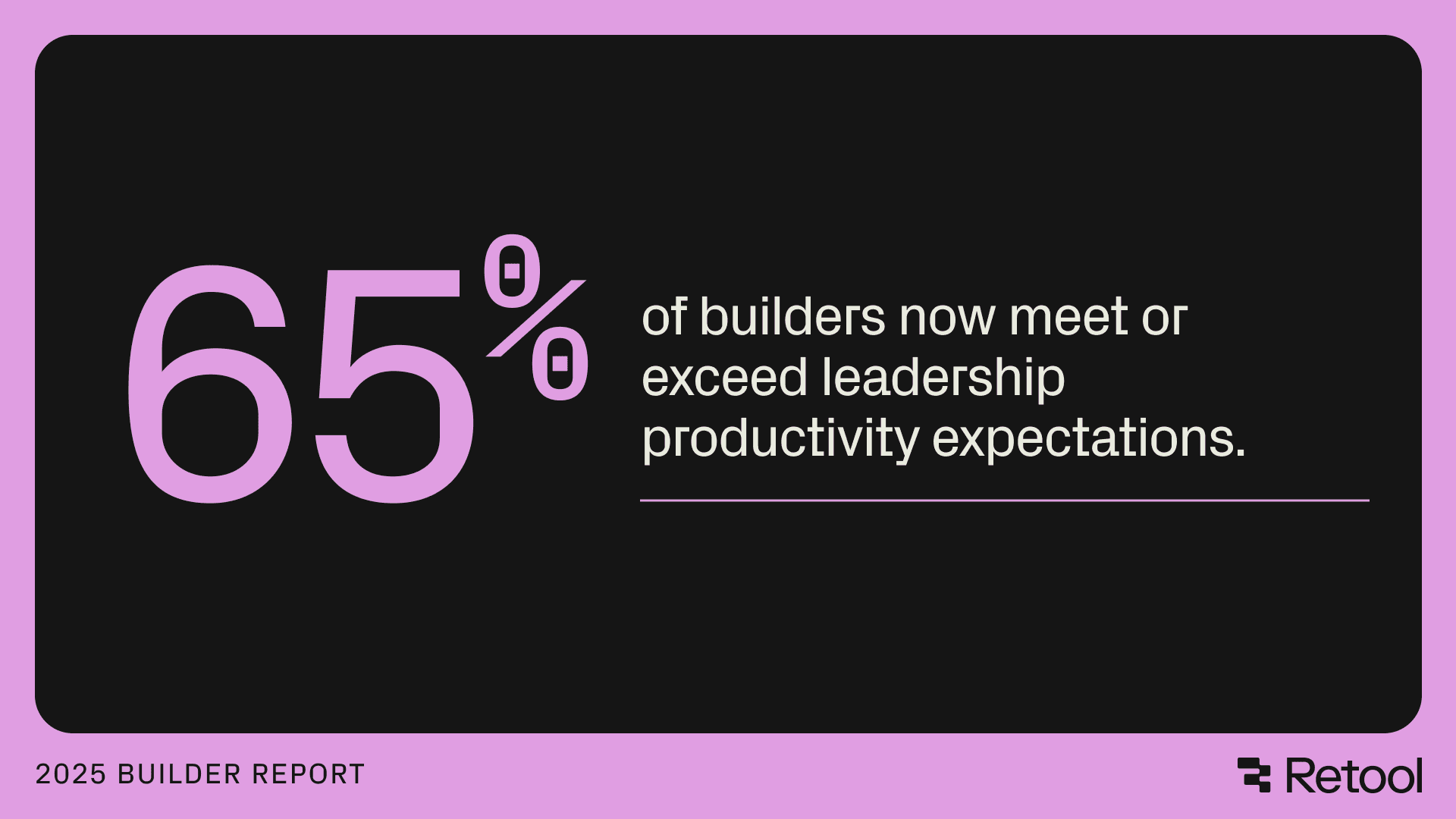
The survey shows a new generation of builders is rising, whose independent problem-solving makes them more productive team members.
Breaking down leadership’s perception of builders, almost half are recognized as people who can “make things happen,” and 35% have become the go-to person for building solutions in their domain. Nearly a quarter (24%) are now involved in strategic technology discussions—a clear indicator of role expansion beyond traditional boundaries.
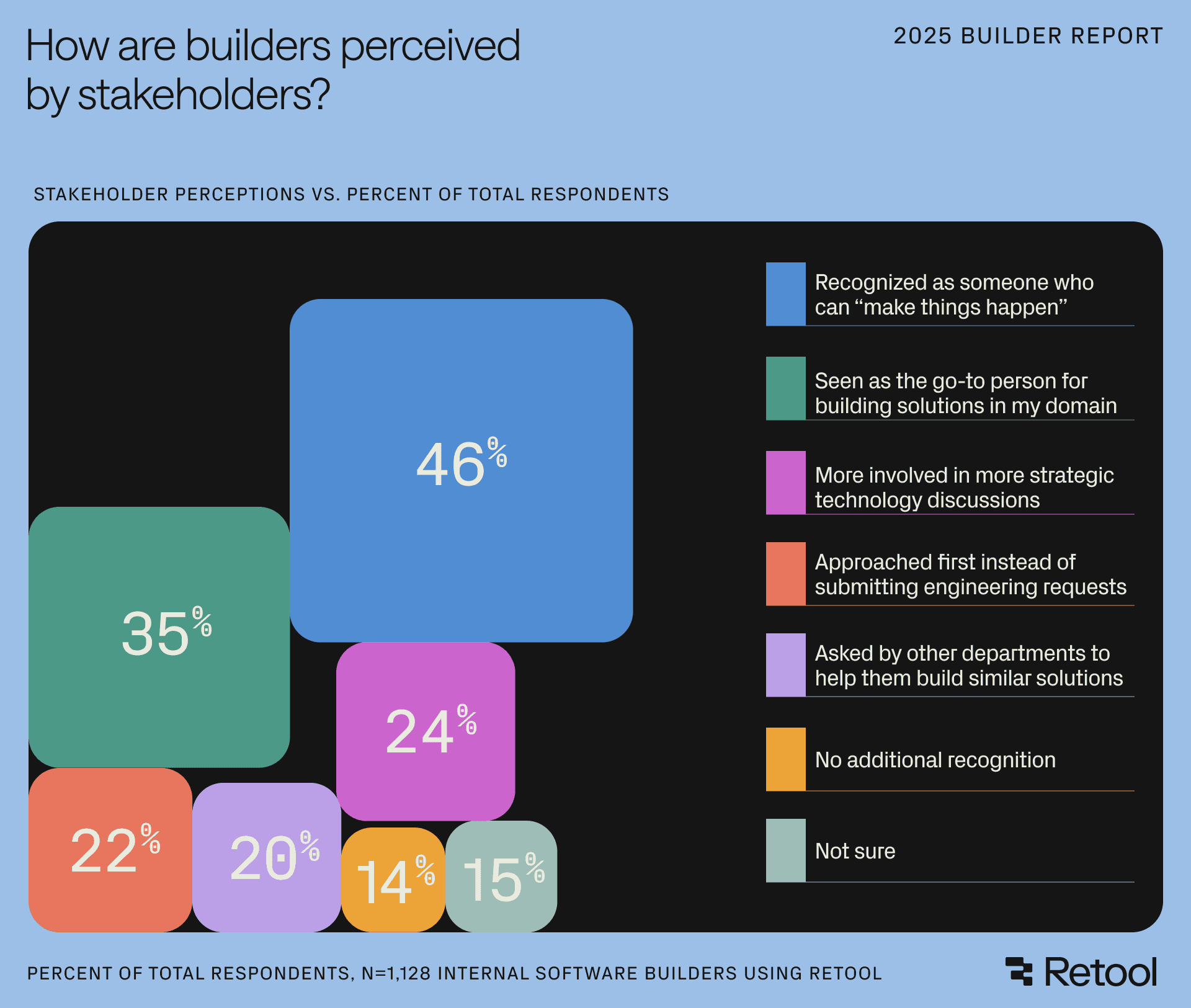
Clearly, leaders notice when builders step up to the plate, even though real productivity ROI from AI tools has proven harder to measure than we thought. What, then, does this mean for process owners who don’t embrace AI-powered problem solving? Time will tell.
An organization’s ability to build a custom tool used to come down to who could code, who owned the tools and platforms, and how much time they had available to solve a problem outside of their scope.
Now, problems that once required engineering approval, project prioritization, and months-long development cycles can be solved in a few days. Business users become the solution-builders, and software engineers evolve into platform enablers and architectural supervisors.
Almost all builders we surveyed (91%) report significant changes to how they work since gaining building capabilities, signaling a fundamental shift in organizational problem-solving dynamics.
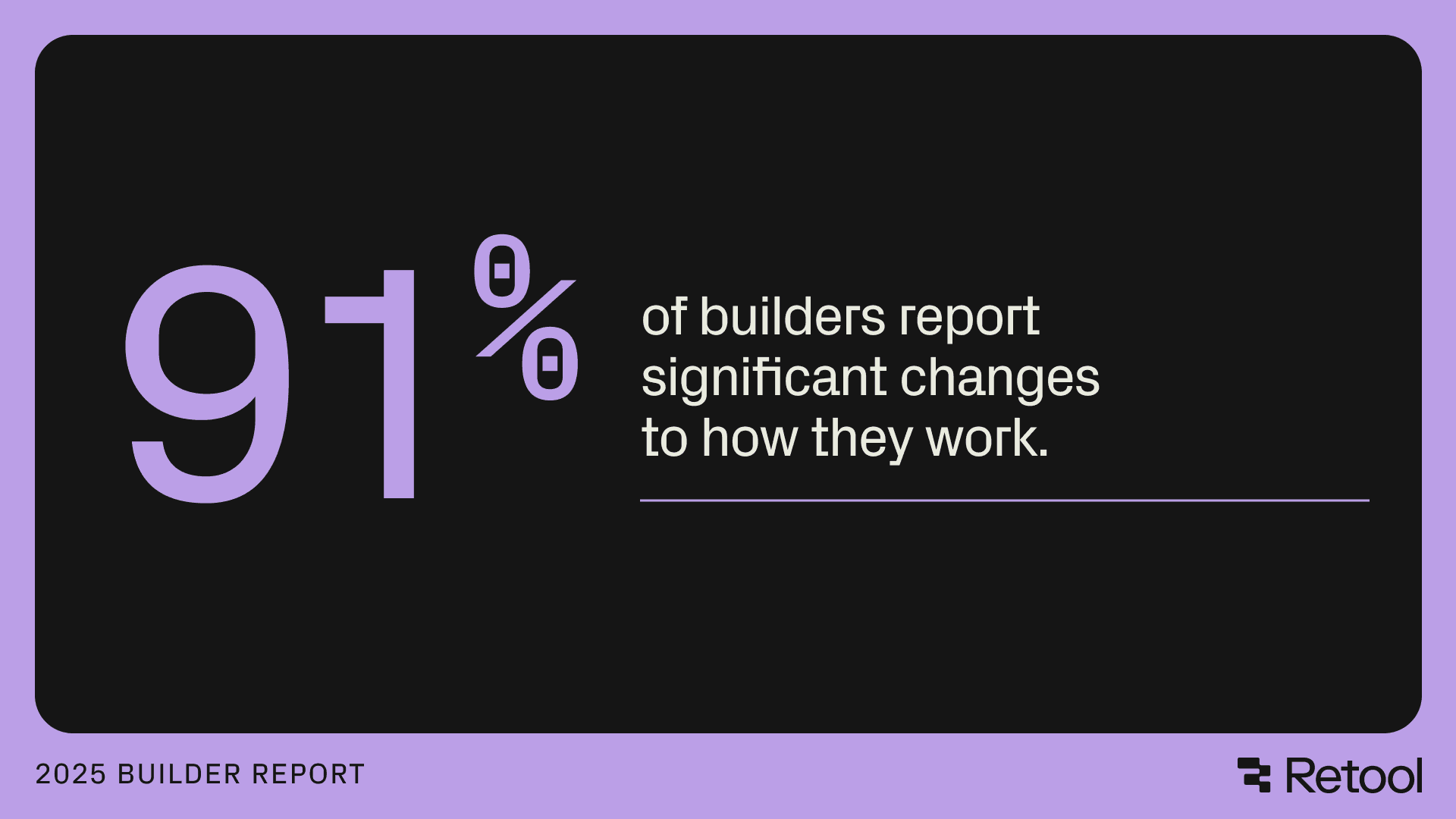
With the right solution and platform, builders can make sure the changes yield a positive impact, not more trouble down the line.
Builders face manual workarounds and limited internal resources when solving business challenges. Before enterprise AppGen, teams were trapped in a cycle of workarounds and dependency. Problem-solving tactics included workarounds in spreadsheets or manual processes (52%), and 44% were creating basic solutions with other tools. Almost half (42%) still had to request engineering resources.
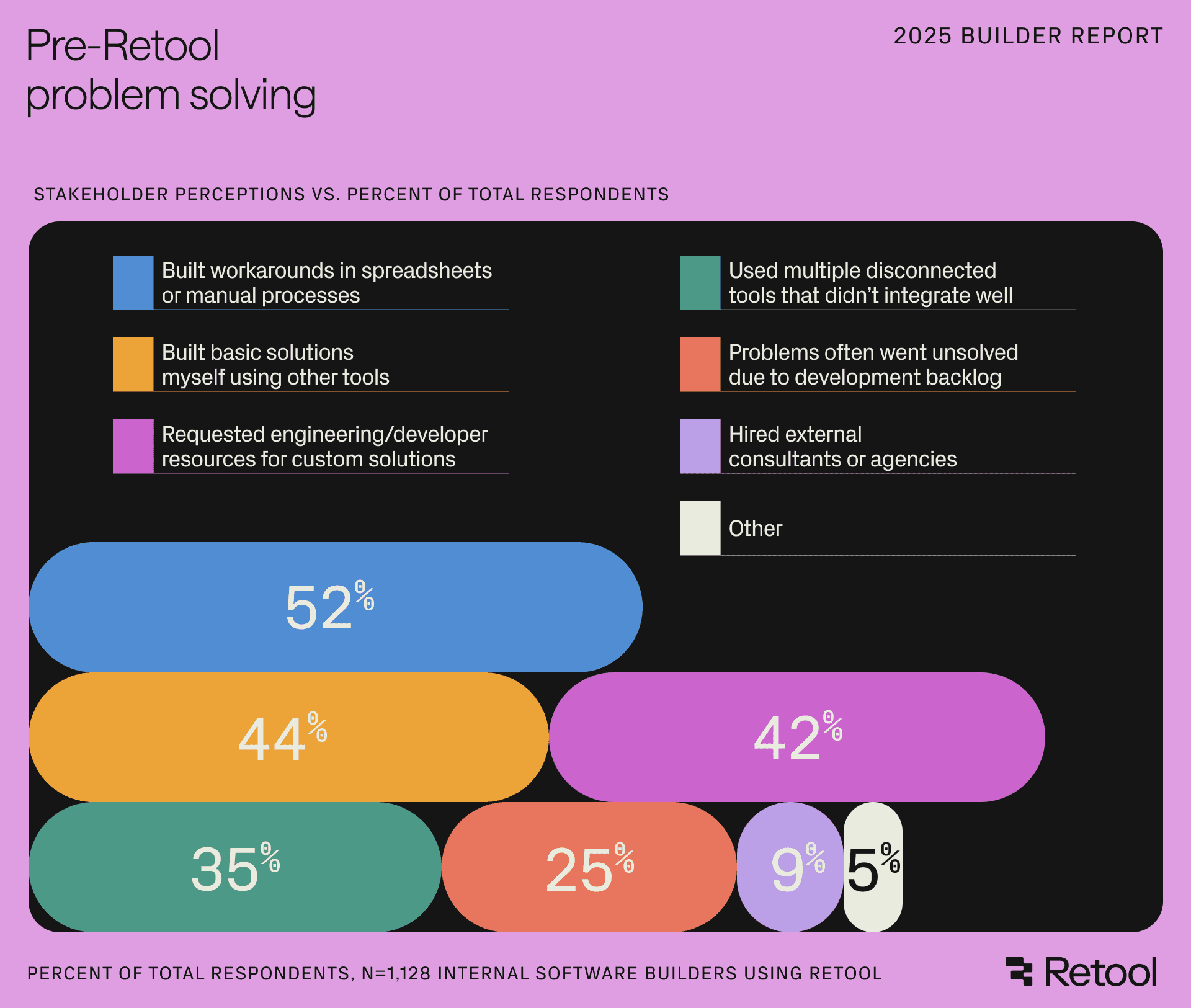
A quarter of problems simply went unsolved due to development backlogs—a huge indictment of traditional resource allocation. Meanwhile, multiple disconnected tools (35%) created integration nightmares, and 9% resorted to expensive external consultants to bridge the gap.
Aaron Schnider, an analytics engineer at Lithic, is one builder who didn’t want to deal with manual processes anymore.
“I wasn’t going to write INSERT and UPDATE statements manually. I would rather spend time cranking out an application over the weekend,” he says.
The custom billing app he created is proof positive that the gap between business expertise and technical execution is shrinking. Enterprise AppGen tools are already unblocking non-technical teams that are accustomed to lengthy request processes and competing priorities.
In every superhero origin story, there’s a moment when the hero learns the boundaries and consequences of their powers before ultimately being able to use them for good. New builders are like these new superheroes. Uniquely equipped to make things better, but at risk of destruction without the right guardrails.
For these builders, the enterprise AppGen capability transformation has been dramatic:
- 51% now solve problems in days or weeks instead of months or quarters
- 48% build solutions directly without waiting for engineering resources
46% create tools that integrate data sources in ways that weren’t possible before.
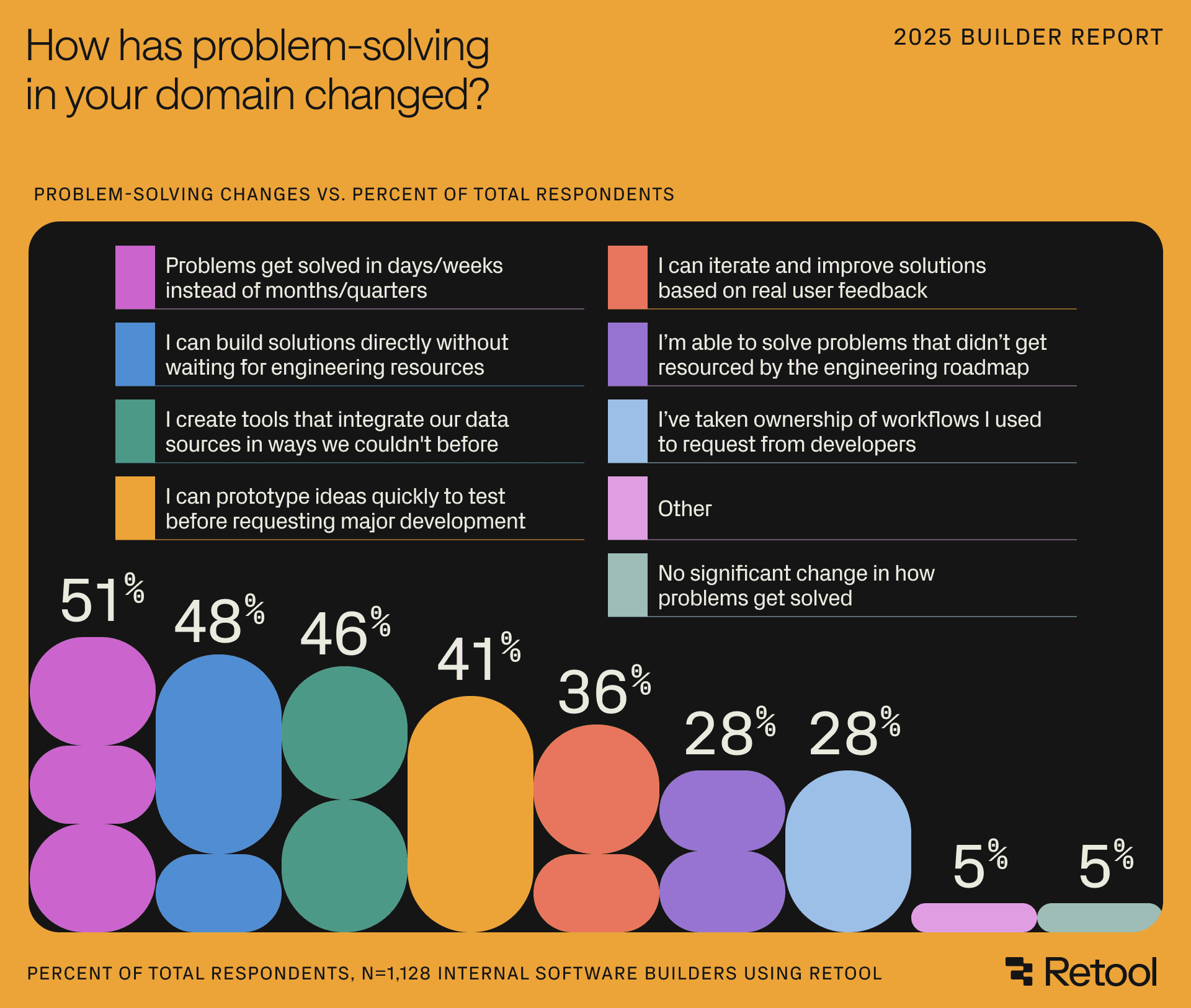
As more non-technical teammates build software, they’ll need guardrails to direct their forward momentum.
Consider a technically-minded marketing agency manager building a commission dashboard. They prompt an AI tool, which generates a working prototype in minutes—but the prompt didn’t account for granularity of who can access what parts of the dashboard. Now, every partner can see each other’s earnings. There’s no authentication, no row-level permissions, no audit trail.
This builder has a choice: spend weeks learning to implement security and governance from scratch, or abandon a solution that could save dozens of hours per week. With these types of constraints, it’s easy to see why so many AI projects are abandoned.
But when generation happens within a governed platform—where authentication, permissions, and query policies actually constrain what’s generated—the outcome changes. Our marketer adds where employee_id = current_user.employee_id and the platform enforces it server-side. IT configures the integration once; builders use it safely without handling credentials. The onus falls on the platform to carry the complex work of security and compliance, not the builder. Now, they’re able to ship secure, production-ready solutions just as quickly as they could prototype insecure ones elsewhere.
The capability shift has the power to change organizational DNA. When business users can build their own solutions in the right environment, the entire company moves faster.
B2B SaaS has long promised to free up employees to do more meaningful work by automating or solving a problem. With enterprise AppGen, that vision is finally becoming a reality—custom software built by the people closest to the problem. Business users get solutions that make their work easier, and builders become organizational force multipliers.
When asked to choose the top change to how they worked, one-third of respondents said they spend less time on manual tasks—the most common response.
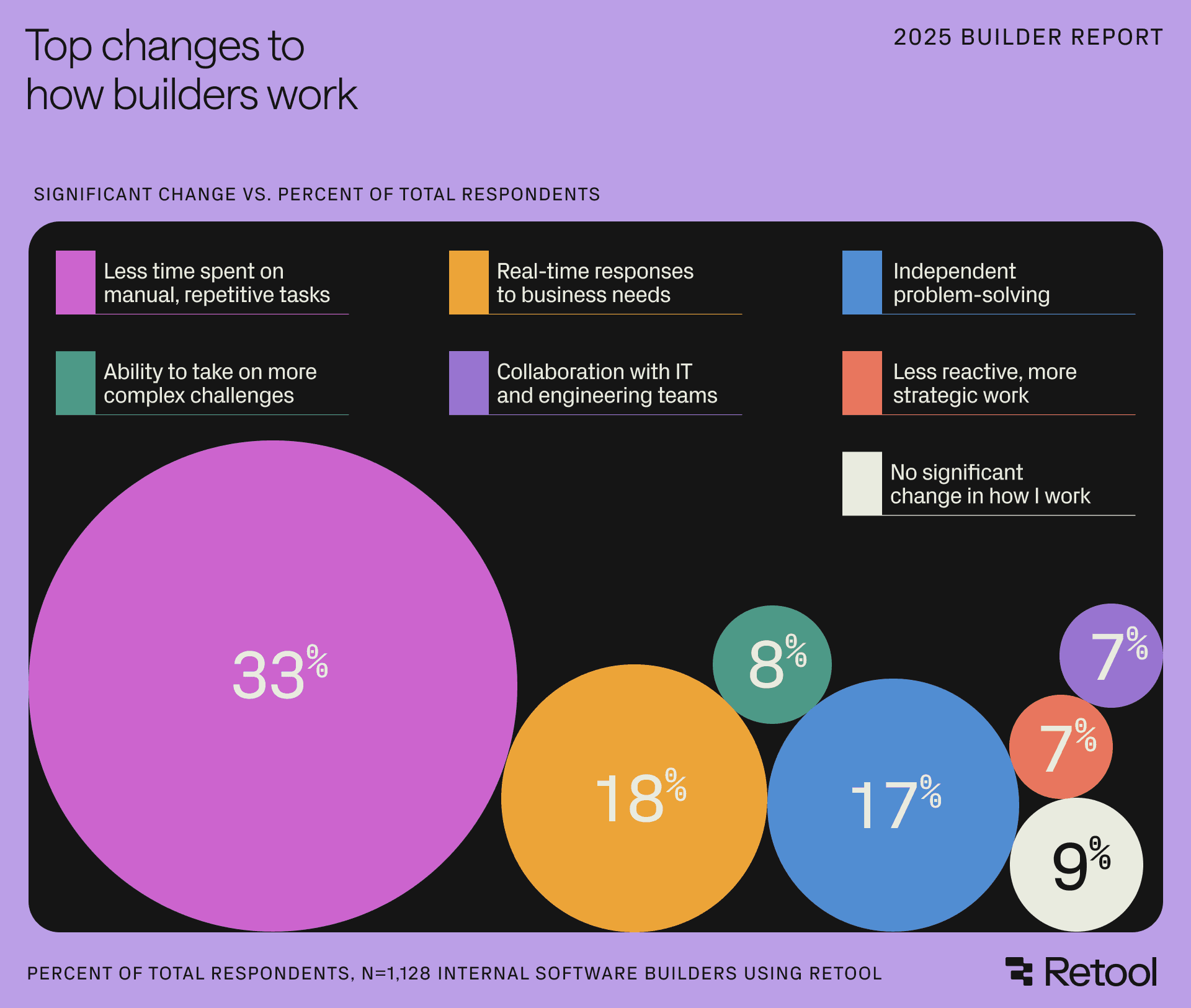
Builders also reported improvements to real-time responses to business needs (18%) and more opportunities for independent problem solving (17%).
Until now, businesses have scaled capacity through hiring or bringing on SaaS tools. Now, a company’s output can scale horizontally across business functions rather than hiring for specific roles or buying expensive software.
This economic impact isn’t limited to hiring and team structure. The build versus buy calculus that has governed enterprise software decisions for decades now includes a third option: build with business users.
The majority of builders (80%) can now go from identifying a problem to solving it without asking for resources or support.
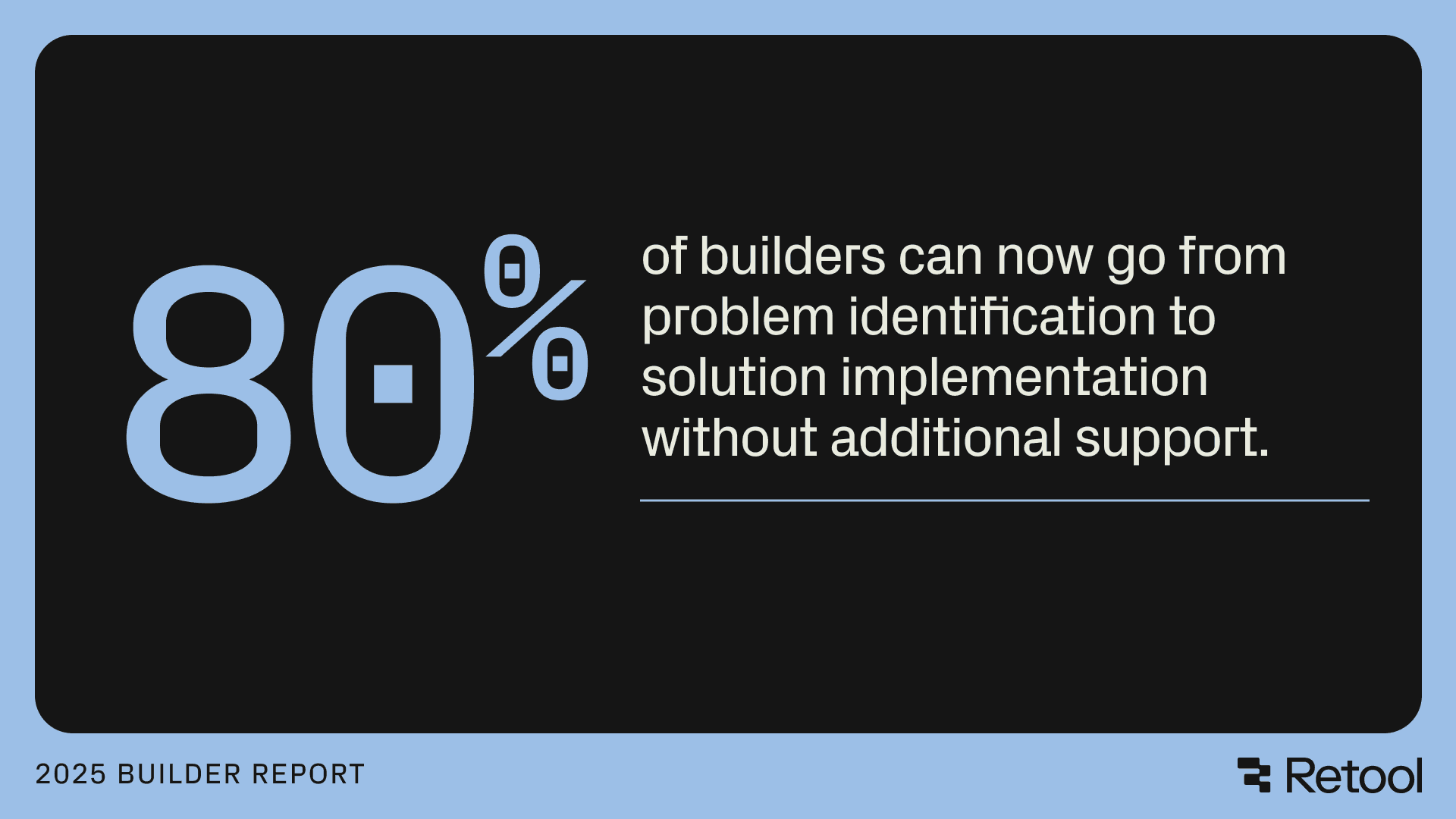
ClickUp’s GTM team built six custom AI tools on Retool that automated hundreds of hours of manual work without adding multiple vendors or involving engineers. The team ultimately saved hundreds of thousands of dollars in headcount costs and vendor expenses. Their inbound SDR agent alone replaced what would have been an expensive point solution, while their Order Form Reviewer eliminated $200k per year in automation software costs.
These solutions evolve with the business instead of constraining it. Purchased software locks organizations into vendor roadmaps and feature limitations. Custom solutions built by business users in their enterprise AppGen environments adapt as quickly as business needs change. And the people building these solutions are becoming more valuable without becoming more expensive.
The real test of this new economic model comes when organizations start measuring impact against their AI mandates.
The internally built custom software approach is driving results for teams under AI mandates. Under these mandates, where careers and budgets depend on demonstrable productivity outcomes, 74% of builders are exceeding leadership’s expectations.
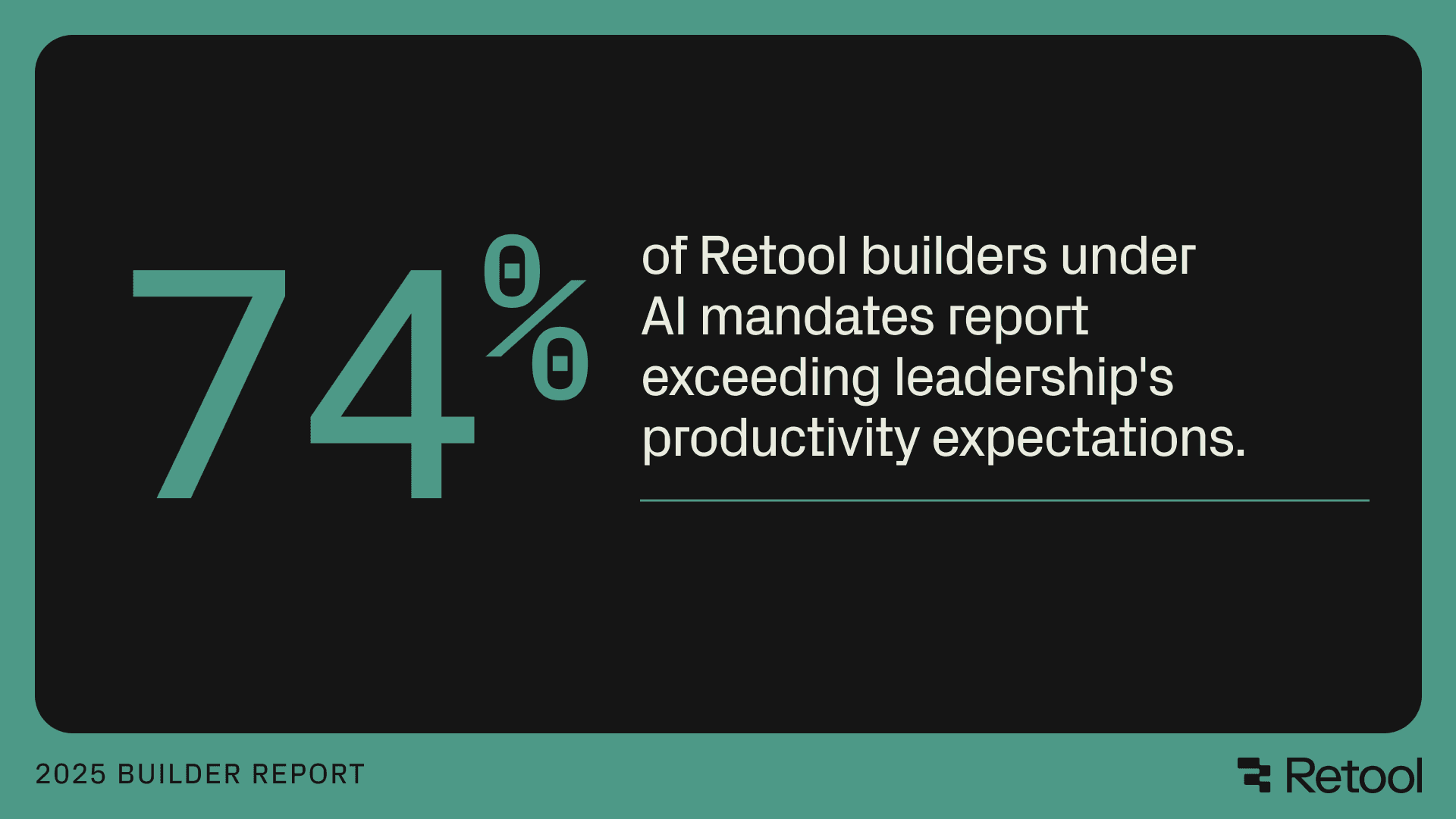
This represents a crucial validation point for the custom software model. Ready-made solutions force businesses to adapt their metrics to what the software can measure, while custom-built solutions like ClickUp’s can track exactly what leadership wants to improve.
The data tells a clear story: when domain experts are empowered to build their own solutions, the entire business benefits.
But giving top performers free rein to vibe code won’t be enough if they don’t have systems in place to support them. Enterprise AppGen platforms create the right conditions of scalable productivity by bridging the gap between AI code generation and production deployment. They connect to live enterprise data and inherit organizational security automatically—turning prototypes into shippable software. This’ll make the difference between compounded productivity and large-scale code cleanup.
The organizations that recognize this shift will be fundamentally restructuring how work gets done, who does it, and how quickly business needs translate into working software.
This report is based on a comprehensive survey conducted in July 2025 across 1,128 Retool builders.
The survey employed a mixed-methods approach, combining quantitative multiple-choice questions with qualitative open-ended responses to capture both measurable trends and nuanced transformation stories.
Reader
